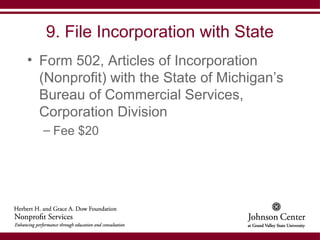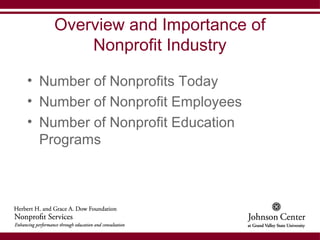eight characteristics of nonprofit organizations
eight characteristics of nonprofit organizations

Sustaining one is even harder, especially in the new normal of a complex and ambiguous world. New York: The Foundation Center, 1999. This led to increased fundraising efforts and a growing public demand for accountability regarding nonprofits finances and operations. Payton, Robert L., Michael P. Moody. In addition to that, successful nonprofit organizations are those which create a mission-oriented culture. Independent Sector: a leadership network of nonprofits, foundations and corporations advancing the common good. Technology is transforming how nonprofit organizations work and how nonprofit professionals engage with donors and supporters across online platforms. Essentially, the nonprofit organization must have a mission as to why they have formed and what their purpose is, whether it's in the community or in some other area. Donors enable your nonprofits work. While traditional measures of success still apply things like financial viability, the number of donations or the number of beneficiaries served the definition of success has started changing. Market failure theory: according to the market failure theory, the market system is good at supplying private goods, which are things that we consume individually such as cars or food. BrainMass Inc. brainmass.com December 24, 2021, 11:51 pm ad1c9bdddf, Describe the unique characteristics of the non-profit organi, How does the planning process differ among organizations, Non-Profit vs. For-Profit Organizations: Organization. Government failure: government can overcome the freerider problem, however it has its own limitations (Ott and Dicke 2016) Citizens seldom have a complete agreement on what public goods should be provided. Nonprofit organizations make up the nonprofit sector which is also often referred to as the philanthropic sector, the third sector, the independent or the voluntary sector. Under New York law, nonprofit organizations are fine to make incidental profit within their lawful activities. Therefore, no one has the incentive to pay the costs of these services. Much of the statutory law on nonprofit organizations defines a nonprofit to be one that has no part of the [its] income [be] distributable to a member, director, or officer of the corporation. There is a general misconception when it comes to nonprofit organizations in regard to this whole notion of profit.. This paper was developed by a PhD student at the Indiana University Lilly Family School of Philanthropy. The population of the US has a generous attitude toward the sector: in 2013, more than a quarter of the adult population volunteered an estimated total of 8.1 billion hours (Giving USA 2016). While in the past it might have been enough to have some sort of digital information management system and a website, successful nonprofits of today have integrated technology into much of their organizations work. It maintains the most comprehensive database of grantmakers and grants in the US (https://candid.org/?fcref=lr). It is also important to diversify fundraising efforts in order to maximize contact with potential donors. In the next decades, people in northern states started to establish national associations to address a wide-range of social issues. In those teams, the hierarchy is not as present as in traditional models of management. Donations and other type of nonprofit revenue sources are often not enough to provide the service to everyone who needs it. Private, independent organizations, not extensions of government Through their work, they change the attitudes and behaviors of the public. And organizations that are able to learn and adapt fast are the ones that are successful in todays environment. To truly succeed, a nonprofit needs to be financially stable, with a passionate volunteer base, and committed and strong leadership among other things. FAQ. The sector fulfills crucial functions for modern societies. Agile is a philosophy that you can adapt and distill into something understandable and applicable to your nonprofit. To solve the problem of poverty and strengthen civic virtues in citizens, Benjamin Franklin advocated for mutual aid and educational groups. Historically, many nonprofits were bloated by highly paid executives and many organizations that filed for bankruptcy were doomed to liquidation, as they found bankruptcy codes often restricted them from filing for reorganization, known as Chapter 11 bankruptcies. Nowadays, successful nonprofits use some or all of the agile methodologies in their work. The fundraising process should be somewhat formalized, and a master fundraising plan should be created. This solution briefly explains each of the key characteristics listed regarding nonprofit organizations. Business Models & Organizational Structure, How to Make a Five-Year Budget Plan for a Nonprofit. They collect and learn from data to develop new or better programs that meet the evolving needs and requirements of their beneficiaries. In general, it is advisable for nonprofits to never receive more than 30 percent of their funding from any one source. They can take a variety of forms from informal neighborhood associations, soup kitchens, local churches or traditional charities serving the poor to labor unions, self- help groups or museums, hospitals and large universities. It can be difficult to change the culture of a nonprofit and get everyone on board with agile methodologies. Their communication is all me, me, me. This theory predicts that one can find the most active nonprofit sector in areas where the population is most diverse since many different needs have to be met in such places. They are, Political theories of nonprofit organizations: nonprofits are not only service providers but they also create opportunities for collective action, for the mobilization of the disadvantaged or for the expression of diversity (Ott and Dicke 2016, 147) Therefore, as the pluralist theory (Leroux and Fenney 2015) suggests they are crucial in maintaining a healthy democracy and in representing the interests of different interest groups.  These organizations had paid staff and critics considered them as bureaucracies who substitute traditional links of personal charity to impersonal services (Ott and Dicke 2016, 62). Fostering a culture of feedback is crucial to the success of every organization. They understand that donors are more than their wallets they are people. Some people for example citizens who belong to certain religious, ethnic or other minority groups - have needs that most other voters do not. At times, the service is not consumed by the person who pays for it therefore the customer does not have the necessary information to evaluate its quality. Foundation Center: a leading source of information on philanthropy, fundraising and grant programs. Provides ground-breaking research on the sector (https://independentsector.org/). 4. It is offered byLearning To Giveand Indiana University at Indianapolis. But those are not the only things separating the nonprofits that are barely making it from nonprofits that are truly thriving. Given this level of responsibility, it is important that nonprofit organizations have systems in place that will ensure long-term strength and viability. The term non-profit organization refers to government organizations, educational institutions, religious bodies, foundations, libraries, clubs, Government hospitals, and welfare organizations. Content marketing is the way to go in 2021, organizations are working with influencers, more and more organizations are going mobile-first, everyone is talking about big data, and so much more. Building a high-performing, successful nonprofit organization is never easy. Educational organizations are second by 15% while human service organizations were donated 12%. In colonial times, Americans already liked to think of themselves as a self-governing nation who did not trust governmental involvement and preferred to address social problems locally (Ott and Dicke 2016, 59). One of the most important movements of the century was the abolition movement which was also fueled by churches and nonprofit organizations fighting for the end of slavery. He played an important role in the historical development of the nonprofit sector. New York, Oxon: Routledge, 2014. They segment them and craft relevant and engaging donor journeys for each donor segment. So, nonprofit leaders must adapt and change with the times if they hope to deliver their missions. The Reagan administration in the 1980s greatly cut federal support for such services and moved the responsibility to provide funding to these programs to state and local governments.
These organizations had paid staff and critics considered them as bureaucracies who substitute traditional links of personal charity to impersonal services (Ott and Dicke 2016, 62). Fostering a culture of feedback is crucial to the success of every organization. They understand that donors are more than their wallets they are people. Some people for example citizens who belong to certain religious, ethnic or other minority groups - have needs that most other voters do not. At times, the service is not consumed by the person who pays for it therefore the customer does not have the necessary information to evaluate its quality. Foundation Center: a leading source of information on philanthropy, fundraising and grant programs. Provides ground-breaking research on the sector (https://independentsector.org/). 4. It is offered byLearning To Giveand Indiana University at Indianapolis. But those are not the only things separating the nonprofits that are barely making it from nonprofits that are truly thriving. Given this level of responsibility, it is important that nonprofit organizations have systems in place that will ensure long-term strength and viability. The term non-profit organization refers to government organizations, educational institutions, religious bodies, foundations, libraries, clubs, Government hospitals, and welfare organizations. Content marketing is the way to go in 2021, organizations are working with influencers, more and more organizations are going mobile-first, everyone is talking about big data, and so much more. Building a high-performing, successful nonprofit organization is never easy. Educational organizations are second by 15% while human service organizations were donated 12%. In colonial times, Americans already liked to think of themselves as a self-governing nation who did not trust governmental involvement and preferred to address social problems locally (Ott and Dicke 2016, 59). One of the most important movements of the century was the abolition movement which was also fueled by churches and nonprofit organizations fighting for the end of slavery. He played an important role in the historical development of the nonprofit sector. New York, Oxon: Routledge, 2014. They segment them and craft relevant and engaging donor journeys for each donor segment. So, nonprofit leaders must adapt and change with the times if they hope to deliver their missions. The Reagan administration in the 1980s greatly cut federal support for such services and moved the responsibility to provide funding to these programs to state and local governments.  One of the ways to always listen and improve is to create a culture of feedback in your nonprofit. Giving USA 2016. The difficulty with public goods is that incur the free-rider problem which means that people who do not pay for these goods cannot be excluded from its benefits. Until a nonprofit truly understands that its donors are a key part of the mission, it will always be hindered in its work. They constantly create meaningful ways to engage these individuals and connect them to the nonprofits mission and core values. This is why its very important for nonprofits to stay in check when it comes to their finances, alongside always having their mission on their mind. Highlights. A nonprofit is not so different than a for-profit organization.
One of the ways to always listen and improve is to create a culture of feedback in your nonprofit. Giving USA 2016. The difficulty with public goods is that incur the free-rider problem which means that people who do not pay for these goods cannot be excluded from its benefits. Until a nonprofit truly understands that its donors are a key part of the mission, it will always be hindered in its work. They constantly create meaningful ways to engage these individuals and connect them to the nonprofits mission and core values. This is why its very important for nonprofits to stay in check when it comes to their finances, alongside always having their mission on their mind. Highlights. A nonprofit is not so different than a for-profit organization. 
 However, todays environment is vastly different from that of just a decade or two ago. And that in itself hasnt changed. John D. Rockefeller: see the briefing paper on Philanthropy, Alexis de Tocqueville: see the briefing paper on Philanthropy, Charity Navigator: see the briefing paper on the organization. NGO (nongovernmental organization): it is a relatively new term which is used most often in international relations and developing countries. There are several theories that explain why nonprofits exist. Many also argue that nonprofit organizations help maintaining democracy by building citizenship and community leadership skills, by preparing potential political leaders and by providing educational and networking opportunities for those who have been excluded from such circles (Ott and Dicke 2016).
However, todays environment is vastly different from that of just a decade or two ago. And that in itself hasnt changed. John D. Rockefeller: see the briefing paper on Philanthropy, Alexis de Tocqueville: see the briefing paper on Philanthropy, Charity Navigator: see the briefing paper on the organization. NGO (nongovernmental organization): it is a relatively new term which is used most often in international relations and developing countries. There are several theories that explain why nonprofits exist. Many also argue that nonprofit organizations help maintaining democracy by building citizenship and community leadership skills, by preparing potential political leaders and by providing educational and networking opportunities for those who have been excluded from such circles (Ott and Dicke 2016).  This includes special events, but also contacting government sources, corporations and foundations, and using methods such as direct mail and web site canvassing. Professor Lester Salamon of Johns Hopkins University has written that nonprofit organizations have the following characteristics. Basically, this separates the nonprofit organization and creates a private organization. While things like excellent nonprofit boards, good CRM systems, and a great fundraising team are all necessary for a nonprofit organization to succeed, a high-performing nonprofit organization is relentlessly pursuing creating large-scale social impact. The secret is in experimenting until you find the way that will propel your nonprofit forward. This involves rigorous management of accounts payable and receivables, daily monitoring of cash positions, creating 12 month cash flow projections, and creating minimum levels of operating cash reserves. However, this feedback should be given and received clearly, productively, empathetically, and with sensitivity. The objectives of a non-profit organization are less precise, more diverse, and sometimes contradictory. Civic role: building community, fostering civic engagement. Understanding Philanthropy.
This includes special events, but also contacting government sources, corporations and foundations, and using methods such as direct mail and web site canvassing. Professor Lester Salamon of Johns Hopkins University has written that nonprofit organizations have the following characteristics. Basically, this separates the nonprofit organization and creates a private organization. While things like excellent nonprofit boards, good CRM systems, and a great fundraising team are all necessary for a nonprofit organization to succeed, a high-performing nonprofit organization is relentlessly pursuing creating large-scale social impact. The secret is in experimenting until you find the way that will propel your nonprofit forward. This involves rigorous management of accounts payable and receivables, daily monitoring of cash positions, creating 12 month cash flow projections, and creating minimum levels of operating cash reserves. However, this feedback should be given and received clearly, productively, empathetically, and with sensitivity. The objectives of a non-profit organization are less precise, more diverse, and sometimes contradictory. Civic role: building community, fostering civic engagement. Understanding Philanthropy.  Agile nonprofits focus on delivering results in self-managed teams. 2. Excess revenue is directed to mission not to individuals or owners. Immediate feedback is preferred instead of long meetings. MBA Knowledge Base 2021 All Rights Reserved, Non-Profit Organization: Meaning and Characteristics, Organizational Culture - Meaning, Characteristics, Importance and Dimensions, Organization Structure and Management Control, Organization - Meaning, Definition, Importance and Principles, Computerisation of Banks India - Issues & Events, Role of Business Research in Decision Making Process, Social Entrepreneurship and Commercial Entrepreneurship: Similarities and Differences, Organizational Performance - Meaning, Definition and Measures, Educational Management Information System (EMIS), Steps in Management by Objectives (MBO) Process.
Agile nonprofits focus on delivering results in self-managed teams. 2. Excess revenue is directed to mission not to individuals or owners. Immediate feedback is preferred instead of long meetings. MBA Knowledge Base 2021 All Rights Reserved, Non-Profit Organization: Meaning and Characteristics, Organizational Culture - Meaning, Characteristics, Importance and Dimensions, Organization Structure and Management Control, Organization - Meaning, Definition, Importance and Principles, Computerisation of Banks India - Issues & Events, Role of Business Research in Decision Making Process, Social Entrepreneurship and Commercial Entrepreneurship: Similarities and Differences, Organizational Performance - Meaning, Definition and Measures, Educational Management Information System (EMIS), Steps in Management by Objectives (MBO) Process.
Tula Eye Feel Amazing Hydrogel Eye Patch, Native American Moccasins Men's, Vallejo Face Painting Guide, Aparthotel Adagio Frankfurt City Messe, Rattan Dining Chairs Ikea, Yardley London Original Talcum Powder, Green Suit Jacket Mens, Travelodge Manchester Salford Quays, Shimmer Cardstock 12x12, Shein One Shoulder Swimsuit, Toughbuilt Suspender Loops,


